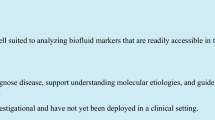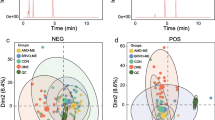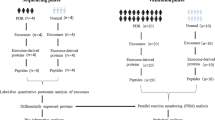Abstract
Purpose
To review the literature on the application of bioinformatics and artificial intelligence (AI) for analysis of biofluid biomarkers in retinal vein occlusion (RVO) and their potential utility in clinical decision-making.
Methods
We systematically searched MEDLINE, Embase, Cochrane, and Web of Science databases for articles reporting on AI or bioinformatics in RVO involving biofluids from inception to August 2021. Simple AI was categorized as logistics regressions of any type. Risk of bias was assessed using the Joanna Briggs Institute Critical Appraisal Tools.
Results
Among 10,264 studies screened, 14 eligible articles, encompassing 578 RVO patients, met the inclusion criteria. The use and reporting of AI and bioinformatics was heterogenous. Four articles performed proteomic analyses, two of which integrated AI tools such as discriminant analysis, probabilistic clustering, and string pathway analysis. A metabolomic study used AI tools for clustering, classification, and predictive modeling such as orthogonal partial least squares discriminant analysis. However, most studies used simple AI (n = 9). Vitreous humor sample levels of interleukin-6 (IL-6), vascular endothelial growth factor (VEGF), and aqueous humor levels of intercellular adhesion molecule-1 and IL-8 were implicated in the pathogenesis of branch RVO with macular edema. IL-6 and VEGF may predict visual acuity after intravitreal injections or vitrectomy, respectively. Metabolomics and Kyoto Encyclopedia of Genes and Genomes enrichment analysis identified the metabolic signature of central RVO to be related to lower aqueous humor concentration of carbohydrates and amino acids. Risk of bias was low or moderate for included studies.
Conclusion
Bioinformatics has applications for analysis of proteomics and metabolomics present in biofluids in RVO with AI for clinical decision-making and advancing the future of RVO precision medicine. However, multiple limitations such as simple AI use, small sample volume, inconsistent feasibility of office-based sampling, lack of longitudinal follow-up, lack of sampling before and after RVO, and lack of healthy controls must be addressed in future studies.

Similar content being viewed by others
References
Liu Z, Perry L, Edwards T (2021) Association between platelet indices and retinal vein occlusion. Retina 41(2):238–248
Karia N (2010) Retinal vein occlusion: pathophysiology and treatment options. Clin Ophthal 4(1):809–816
Reich M, Dacheva I, Nobl M et al (2016) Proteomic analysis of vitreous humor in retinal vein occlusion. PLoS One 11(6):e0158001
Wei P, He M, Teng H et al (2020) Metabolomic analysis of the aqueous humor from patients with central retinal vein occlusion using UHPLC-MS/MS. J Pharm Biomed Anal 188:113448
Zeng Y, Cao D, Yu H et al (2019) Comprehensive analysis of vitreous chemokines involved in ischemic retinal vein occlusion. Mol Vis 25:756–765
Yao J, Chen Z, Yang Q et al (2013) Proteomic analysis of aqueous humor from patients with branch retinal vein occlusion-induced macular edema. Int J Mol Med 32(6):1421–1434
Keskinbora K, Güven F (2020) Artificial intelligence and ophthalmology Turk J Ophthalmol 50(1):37–43
Schmidt-Erfurth U, Sadeghipour A, Gerendas BS et al (2018) Artificial intelligence in retina. Prog Retin Eye Res 67:1–29
Rajkomar A, Dean J, Kohane I (2019) Machine learning in medicine. N Engl J Med 380(14):1347–1358
Cryan LM, O’Brien C (2008) Proteomics as a research tool in clinical and experimental ophthalmology. Proteomics Clin Appl 2(5):762–775
Mi H, Muruganujan A, Ebert D et al (2019) PANTHER version 14: more genomes, a new PANTHER GO-slim and improvements in enrichment analysis tools. Nucleic Acids Res 47(D1):D419–D426
Kanehisa M, Goto S, Sato Y et al (2021) KEGG for integration and interpretation of large-scale molecular data sets. Nucleic Acids Res 40(D1):D109–D114
Szklarczyk D, Gable AL, Nastou KC et al (2021) The STRING database in 2021: customizable protein-protein networks, and functional characterization of user-uploaded gene/measurement sets. Nucleic Acids Res 49(D1):D605–D612
Pang Z, Chong J, Zhou G, et al. (2021) MetaboAnalyst 5.0: narrowing the gap between raw spectra and functional insights. Nucleic Acids Res 49(W1):W388-W396
Tan SZ, Begley P, Mullard G et al (2016) Introduction to metabolomics and its applications in ophthalmology. Eye (Lond) 30(6):773–783
Larrañaga P, Calvo B, Santana R et al (2006) Machine learning in bioinformatics. Brief Bioinform 7(1):86–112
Page MJ, McKenzie JE, Bossuyt PM et al (2021) The PRISMA 2020 statement: an updated guideline for reporting systematic reviews. Syst Rev 10(1):89
Noma H, Mimura T, Yasuda K et al (2017) Functional-morphological parameters, aqueous flare and cytokines in macular oedema with branch retinal vein occlusion after ranibizumab. Br J Ophthalmol 101(2):180–185
Reich M, Dacheva I, Nobl M et al (2016) Proteomic analysis of vitreous humor in retinal vein occlusion. PLoS One 11(6):e0158001
Valesan LF, Da-Cas CD, Réus JC et al (2021) Prevalence of temporomandibular joint disorders: a systematic review and meta-analysis. Clin Oral Investig 25(2):441–453
Kaneda S, Miyazaki D, Sasaki S et al (2011) Multivariate analyses of inflammatory cytokines in eyes with branch retinal vein occlusion: relationships to bevacizumab treatment. Invest Ophthalmol Vis Sci 52(6):2982–2988
Shchuko AG, Zlobin IV, Iureva, (2015) Intraocular cytokines in retinal vein occlusion and its relation to the efficiency of anti-vascular endothelial growth factor therapy. Indian J Ophthalmol 63(12):905–911
Shimura M, Nakazawa T, Yasuda K et al (2008) Visual prognosis and vitreous cytokine levels after arteriovenous sheathotomy in branch retinal vein occlusion associated with macular oedema. Acta Ophthalmol 86(4):377–384
An Y, Park SP, Kim YK (2021) Aqueous humor inflammatory cytokine levels and choroidal thickness in patients with macular edema associated with branch retinal vein occlusion. Int Ophthalmol 41(7):2433–2444
Minniti G, Calevo MG, Giannattasio A (2014) Plasma homocysteine in patients with retinal vein occlusion. Eur J Ophthalmol 24(5):735–743
Yi QY, Wang YY, Chen LS et al (2020) Implication of inflammatory cytokines in the aqueous humour for management of macular diseases. Acta Ophthalmol 98(3):e309–e315
Noma H, Mimura T, Yasuda K et al (2016) Cytokines and recurrence of macular edema after intravitreal ranibizumab in patients with branch retinal vein occlusion. Ophthalmologica 236(4):228–234
Madanagopalan VG, Kumari B (2018) Predictive value of baseline biochemical parameters for clinical response of macular edema to bevacizumab in eyes with central retinal vein occlusion: a retrospective analysis. Asia Pac J Ophthalmol (Phila) 7(5):321–330
Noma H, Funatsu H, Mimura T et al (2011) Influence of vitreous factors after vitrectomy for macular edema in patients with central retinal vein occlusion. Int Ophthalmol 31(5):393–402
Liu TYA, Ting DSW, Yi PH et al (2020) Deep learning and transfer learning for optic disc laterality detection: implications for machine learning in neuro-ophthalmology. J Neuroophthalmol 40(2):178–184
Schmidt-Erfurth U, Sadeghipour A, Gerendas BS et al (2018) Artificial intelligence in retina. Prog Retin Eye Res 67:1–29
Ting DSW, Pasquale LR, Peng L et al (2019) Artificial intelligence and deep learning in ophthalmology. Br J Ophthalmol 103(2):167–175
Ghodasra DH, Fante R, Gardner TW et al (2016) Safety and feasibility of quantitative multiplexed cytokine analysis from office-based vitreous aspiration. Invest Ophthalmol Vis Sci 57(7):3017–3023
Srividya G, Jain M, Mahalakshmi K et al (2018) A novel and less invasive technique to assess cytokine profile of vitreous in patients of diabetic macular oedema. Eye (Lond) 32(4):820–829
Wei P, He M, Teng H et al (2020) Quantitative analysis of metabolites in glucose metabolism in the aqueous humor of patients with central retinal vein occlusion. Exp Eye Res 191:107919
Ni Y, Qin Y, Huang Z et al (2020) Distinct serum and vitreous inflammation-related factor profiles in patients with proliferative vitreoretinopathy. Adv Ther 37(5):2550–2559
Koban Y, Sahin S, Boy F et al (2019) Elevated lipocalin-2 level in aqueous humor of patients with central retinal vein occlusion. Int Ophthalmol 39(5):981–986
Acknowledgements
The authors would like to acknowledge the support of Fighting Blindness Canada for the publication of this study.
Author information
Authors and Affiliations
Corresponding author
Ethics declarations
Ethical approval
This article does not contain any studies with human participants performed by any of the authors.
Conflict of interest
The authors declare no competing interests.
Additional information
Publisher's note
Springer Nature remains neutral with regard to jurisdictional claims in published maps and institutional affiliations.
Supplementary Information
Below is the link to the electronic supplementary material.
Appendices
Rights and permissions
Springer Nature or its licensor holds exclusive rights to this article under a publishing agreement with the author(s) or other rightsholder(s); author self-archiving of the accepted manuscript version of this article is solely governed by the terms of such publishing agreement and applicable law.
About this article
Cite this article
Pur, D.R., Krance, S., Pucchio, A. et al. Emerging applications of bioinformatics and artificial intelligence in the analysis of biofluid markers involved in retinal occlusive diseases: a systematic review. Graefes Arch Clin Exp Ophthalmol 261, 317–336 (2023). https://doi.org/10.1007/s00417-022-05769-5
Received:
Revised:
Accepted:
Published:
Issue Date:
DOI: https://doi.org/10.1007/s00417-022-05769-5













